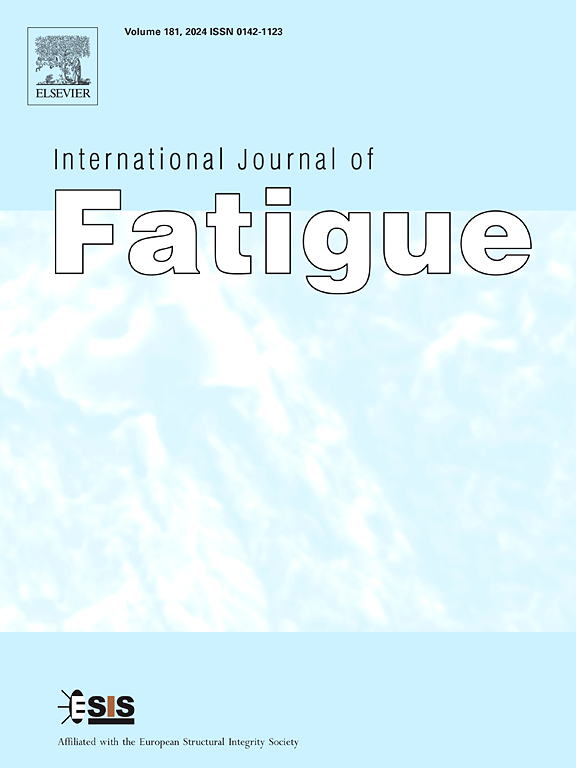Temperature-dependent whole-life ratcheting of ER9 wheel steel: Experiments and modeling
IF 6.8
2区 材料科学
Q1 ENGINEERING, MECHANICAL
引用次数: 0
Abstract
Monotonic tensile tests are conducted on ER9 wheel steel across a temperature range from 298 K to 873 K to obtain temperature-dependent mechanical properties. The results indicate a significant additional strengthening effect at approximately 573 K, which is attributed to the dynamic strain aging. Asymmetric stress-controlled fatigue tests are conducted at 298 K, 573 K, and 873 K to investigate the whole-life ratcheting, thereby indicating the evolution of ratcheting strain and damage. Based on experimental observations, a new cyclic plastic constitutive model is developed to capture the temperature-dependent evolutions of isotropic and kinematic hardenings. An exponential term is incorporated into the damage evolution equation to account for the observed differences in the evolution of damage variables at various temperatures. Consequently, a temperature-dependent damage-coupled cyclic constitutive model was established. A comparison between simulated and experimental results indicates that the proposed model accurately captures the whole-life ratcheting of ER9 wheel steel within the range of room temperature to high temperature. Moreover, the predicted fatigue lives fall within a twice-error band. The findings are expected to provide theoretical support for the thermo-mechanically coupled fatigue damage of wheel steel under severe creepage conditions.
ER9车轮钢的全寿命棘轮的温度依赖性:实验和建模
对ER9车轮钢在298 K至873 K的温度范围内进行单调拉伸试验,以获得与温度相关的机械性能。结果表明,在573 K左右存在明显的附加强化效应,这是由动态应变时效引起的。在298k、573k和873k下进行了非对称应力控制疲劳试验,研究了棘轮的全寿命,从而揭示了棘轮应变和损伤的演变过程。基于实验观察,建立了一个新的循环塑性本构模型,以捕捉各向同性和运动硬化的温度依赖演变。在损伤演化方程中加入指数项来解释在不同温度下观察到的损伤变量演化的差异。建立了温度相关损伤耦合循环本构模型。仿真结果与实验结果的对比表明,所提出的模型能够准确地捕捉ER9轮钢在室温至高温范围内的全寿命棘轮活动。此外,预测疲劳寿命落在二次误差范围内。研究结果有望为车轮钢在严重蠕滑工况下的热-机耦合疲劳损伤研究提供理论支持。
本文章由计算机程序翻译,如有差异,请以英文原文为准。
求助全文
约1分钟内获得全文
求助全文
来源期刊

International Journal of Fatigue
工程技术-材料科学:综合
CiteScore
10.70
自引率
21.70%
发文量
619
审稿时长
58 days
期刊介绍:
Typical subjects discussed in International Journal of Fatigue address:
Novel fatigue testing and characterization methods (new kinds of fatigue tests, critical evaluation of existing methods, in situ measurement of fatigue degradation, non-contact field measurements)
Multiaxial fatigue and complex loading effects of materials and structures, exploring state-of-the-art concepts in degradation under cyclic loading
Fatigue in the very high cycle regime, including failure mode transitions from surface to subsurface, effects of surface treatment, processing, and loading conditions
Modeling (including degradation processes and related driving forces, multiscale/multi-resolution methods, computational hierarchical and concurrent methods for coupled component and material responses, novel methods for notch root analysis, fracture mechanics, damage mechanics, crack growth kinetics, life prediction and durability, and prediction of stochastic fatigue behavior reflecting microstructure and service conditions)
Models for early stages of fatigue crack formation and growth that explicitly consider microstructure and relevant materials science aspects
Understanding the influence or manufacturing and processing route on fatigue degradation, and embedding this understanding in more predictive schemes for mitigation and design against fatigue
Prognosis and damage state awareness (including sensors, monitoring, methodology, interactive control, accelerated methods, data interpretation)
Applications of technologies associated with fatigue and their implications for structural integrity and reliability. This includes issues related to design, operation and maintenance, i.e., life cycle engineering
Smart materials and structures that can sense and mitigate fatigue degradation
Fatigue of devices and structures at small scales, including effects of process route and surfaces/interfaces.
 求助内容:
求助内容: 应助结果提醒方式:
应助结果提醒方式:


